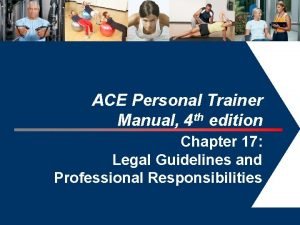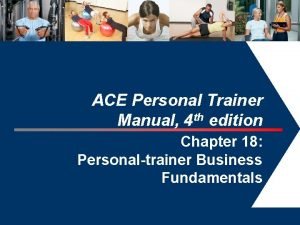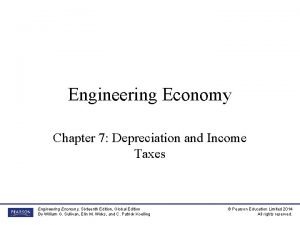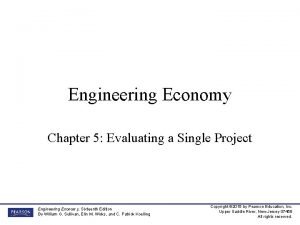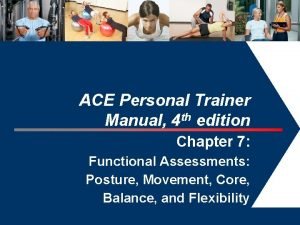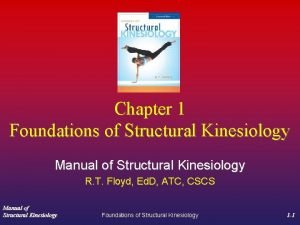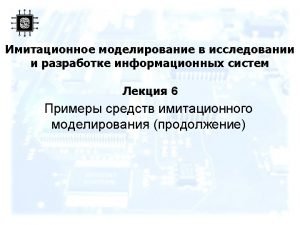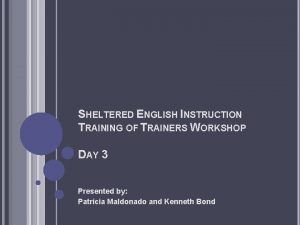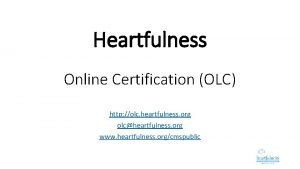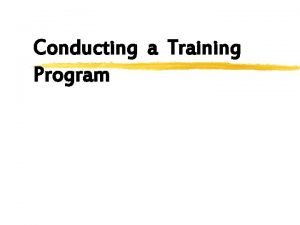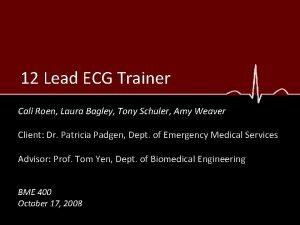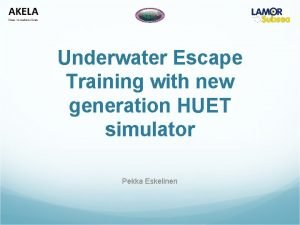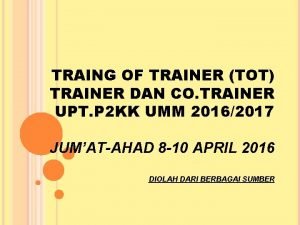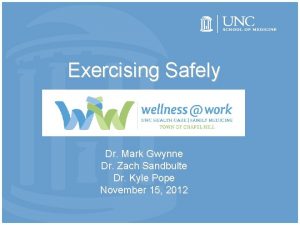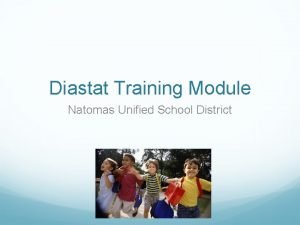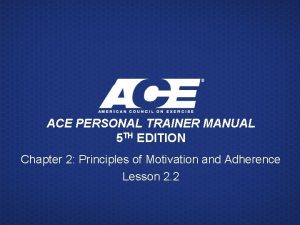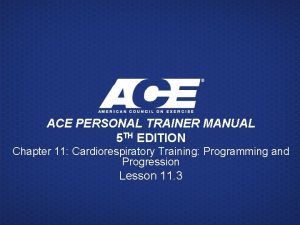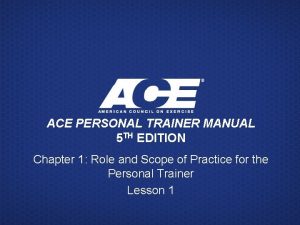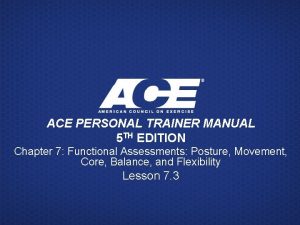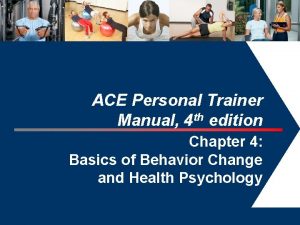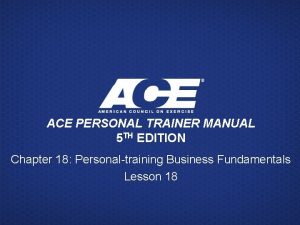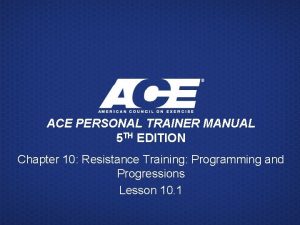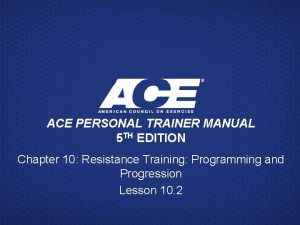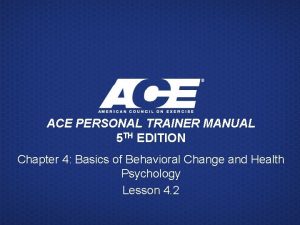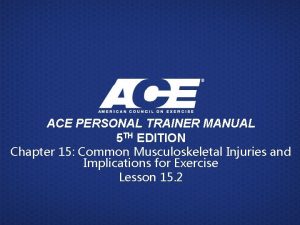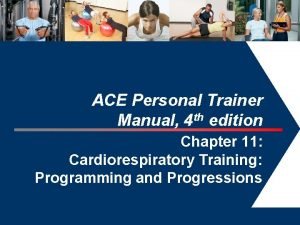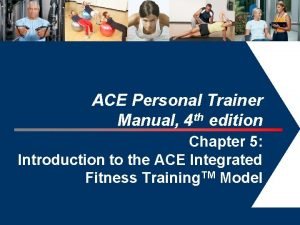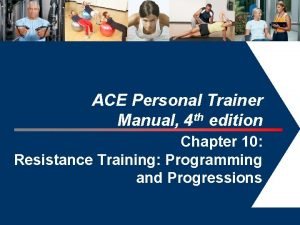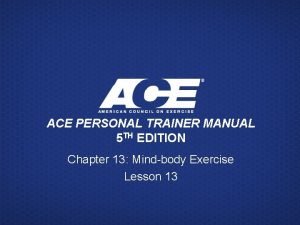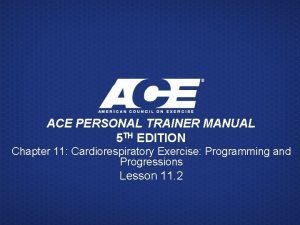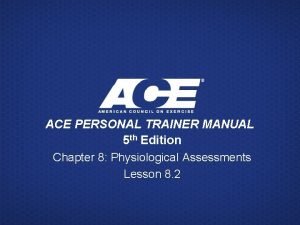ACE PERSONAL TRAINER MANUAL 5 th Edition Chapter
































- Slides: 32

ACE PERSONAL TRAINER MANUAL 5 th Edition Chapter 8: Physiological Assessments Lesson 8. 1

LEARNING OBJECTIVES • After completing this session, you will be able to: ü Identify signs and symptoms that merit immediate test termination ü Discuss various anthropometric measurements and body-composition assessments, and the appropriateness of each test ü Demonstrate various measurements to determine and evaluate body composition or risk category, including skinfold, body mass index, girth, waist-tohip ratio, and waist circumference © 2014 ACE

TESTING AND MEASUREMENT • Identifiable signs or symptoms that merit immediate test termination: ü Onset of angina, chest pain, or angina-like symptoms ü Significant drop (>10 mm. Hg) in systolic blood pressure (SBP) despite an increase in exercise intensity ü Excessive rise in blood pressure (BP): SBP reaches >250 mm. Hg or diastolic blood pressure (DBP) reaches >115 mm. Hg ü Excess fatigue, shortness of breath, or wheezing (does not include heavy breathing due to intense exercise) © 2014 ACE

TESTING AND MEASUREMENT • Identifiable signs or symptoms that merit immediate test termination (cont. ): ü Signs of poor perfusion: lightheadedness, pallor, cyanosis, nausea, or cold and clammy skin ü Increased nervous system symptoms (e. g. , ataxia, dizziness, confusion, or syncope) ü Leg cramping or claudication ü Subject requests to stop ü Physical or verbal manifestations of severe fatigue ü Failure of testing equipment © 2014 ACE

ANTHROPOMETRIC MEASUREMENTS AND BODY COMPOSITION • Anthropometry – the measurement of the size and proportions of the human body for the purposes of understanding human physical variation • Anthropometric measures – measurements of height, weight, and/or circumference to assess body size or dimension: ü Easy to administer ü Require minimal equipment ü Demonstrate strong correlations to health, morbidity, and mortality ü Provide only estimations of body composition and fitness level © 2014 ACE

ANTHROPOMETRIC MEASUREMENTS AND BODY COMPOSITION • Body composition – the proportion of lean tissue to body-fat tissue • Lean body mass (LBM): ü Muscles, connective tissue, bones, blood, nervous tissue, skin, and organs ü Metabolically active tissue that allows the body to perform work • Essential body fat: ü Necessary for insulation and thermoregulation, hormone production, cushioning of vital organs, and maintenance of certain body functions • Adipose tissue: ü Non-essential body fat that is stored throughout the body ü Either subcutaneously or viscerally ü Acts as a readily available source of energy or to cushion and protect vital organs © 2014 ACE

BODY COMPOSITION AND BODY SIZE MEASUREMENT TECHNIQUES © 2014 ACE

MEASUREMENT OF LEAN AND FAT MASS • Overweight: ü An upward deviation in body weight, based on the subject’s height ü 20% or more above ideal weight • Overfat: ü An excess amount of body fat ü A more accurate depiction of body composition © 2014 ACE

BODY-COMPOSITION ASSESSMENTS © 2014 ACE

BODY-COMPOSITION ASSESSMENTS © 2014 ACE

HYDROSTATIC WEIGHING • The body is weighed on an underwater scale. • 1. 5 to 2. 0% margin of error • Most other methods of measuring body composition are based on formulas derived from underwater weighing research. • Not a practical approach for the standard fitness center: ü ü © 2014 ACE Expensive Requires a lot of space Testing takes time and expertise Many people feel uncomfortable remaining submerged underwater after they have exhaled all available air from their lungs

SKINFOLD MEASUREMENTS • Subcutaneous body fat – can be measured using a skinfold caliper: ü ü Most practical and widely used method Ease of administration Low cost Produces a measurement that is ± 2. 0 to 3. 5% of that obtained in hydrostatic weighing • Jackson and Pollock three-site skinfold measurements: ü For men: Chest, thigh, and abdominal ü For women: Triceps, thigh, and suprailium © 2014 ACE

JACKSON AND POLLOCK 3 -SITE SKINFOLD MEASUREMENTS: MEN © 2014 ACE

JACKSON AND POLLOCK 3 -SITE SKINFOLD MEASUREMENTS: MEN © 2014 ACE

JACKSON AND POLLOCK 3 -SITE SKINFOLD MEASUREMENTS: MEN © 2014 ACE

JACKSON AND POLLOCK 3 -SITE SKINFOLD MEASUREMENTS: WOMEN © 2014 ACE

JACKSON AND POLLOCK 3 -SITE SKINFOLD MEASUREMENTS: WOMEN © 2014 ACE

JACKSON AND POLLOCK 3 -SITE SKINFOLD MEASUREMENTS: WOMEN © 2014 ACE

GENERAL BODY-FAT PERCENTAGE CATEGORIES © 2014 ACE

BODY MASS INDEX (BMI) • Extensively used in healthcare settings to determine health risk and/or to establish target weight levels • Provides an objective ratio describing the relationship between body weight and height • Cannot determine actual body composition • BMI can unfairly categorize some individuals: ü Extremely muscular or large framed individuals can score high, resulting in “overweight” or “obese” category ü Older adults with decreased lean tissue and excess body fat may score “normal” • BMI = Weight (kg)/Height 2 (m) © 2014 ACE

BMI REFERENCE CHART © 2014 ACE

BMI CATEGORIZATION An active, well-muscled client has recently participated in his employer’s wellness fair. He reports to you that, based on his weight and height measurements, he falls into the “overweight” category. However, according to the body-composition assessment you have conducted with him, he is considered healthy and not in danger of being overweight. How would you explain this discrepancy to your client? © 2014 ACE

GIRTH MEASUREMENTS • Good predictors of health problems (e. g. , waist circumference as it correlates to heart disease) • Provides motivation as clients see changes in their body dimensions: ü Those interested in weight loss will be inspired by smaller numbers ü Individuals interested in muscular hypertrophy may be motivated by increases in girth © 2014 ACE

CIRCUMFERENCE SITES AND PROCEDURES © 2014 ACE

CIRCUMFERENCE SITES AND PROCEDURES © 2014 ACE

ANATOMICAL LANDMARKS FOR GIRTH MEASUREMENTS © 2014 ACE

WAIST-TO-HIP RATIO (WHR) • The location of fat deposits may be a better indicator of disease risk. • WHR helps to differentiate between: ü Gynoid (pear-shaped) individuals – excess fat in the hips and thighs ü Android (apple-shaped) individuals – excess fat in the abdominal area • Greater health risk with a high WHR © 2014 ACE

WAIST CIRCUMFERENCE • Non-essential visceral fat contributes to android fat distribution: ü Encroaches on the vital organs of the body ü Excess abdominal fat has been associated with insulin resistance. ü Strong correlation between excess abdominal fat and a number of health risks • For every 1 -inch increase in waist circumference in men: ü BP increases by 10% ü Blood cholesterol level increases by 8% ü High-density lipoprotein (HDL) decreases by 15% ü Triglycerides increase by 18% ü Metabolic syndrome risk increases by 18% © 2014 ACE

CRITERIA FOR WAIST CIRCUMFERENCE IN ADULTS © 2014 ACE

ANTHROPOMETRIC TESTING PROTOCOLS • Testing protocols are similar for all the anthropometric tests: ü Perform prior to exercise ü Explain the procedure and ensure the client is comfortable with the proposed measurement sites ü Each measurement must be performed using the precise landmarks ü Record values, evaluate, and classify the measurements using normative data ü Discuss the concerns related to abnormal readings ü Educate clients on strategies to reduce risk and improve overall health © 2014 ACE

LONG-TERM WEIGHT MANAGEMENT • Many people are often successful at losing weight or fat, but are unsuccessful at long-term weight management. • Personal trainers must emphasize that exercise is a key component not only in effective weight loss, but also in maintaining a healthy weight. ü Exercise enhances daily caloric expenditure. ü Exercise, especially strength training, can minimize the loss of lean body weight. ü Exercise may suppress appetite and counteract the impact that diet may have on resting metabolic rate (RMR). ü Exercise makes the body more efficient at burning fat. © 2014 ACE

SUMMARY • Assessments are an integral part of any personal-training program. • In addition to determining the appropriateness of various assessments, it is very important for a trainer to identify the signs and symptoms that merit immediate test termination. • When conducted properly, anthropometric measurements and body-composition assessments can provide valuable health information for a trainer to use in designing programs. • Periodic reassessments are also important to gauge progress and continue to foster the client–trainer relationship. © 2014 ACE
 Personal trainer liability insurance ace
Personal trainer liability insurance ace Personal trainer swot analysis
Personal trainer swot analysis Engineering economy 16th edition solution manual chapter 5
Engineering economy 16th edition solution manual chapter 5 Engineering economy 16th edition chapter 5 solutions
Engineering economy 16th edition chapter 5 solutions Engineering economy 16th edition solution manual chapter 3
Engineering economy 16th edition solution manual chapter 3 Apley scratch test
Apley scratch test Using mis 10th edition
Using mis 10th edition Using mis (10th edition) 10th edition
Using mis (10th edition) 10th edition Manual of structural kinesiology 18th edition
Manual of structural kinesiology 18th edition Personal finance 6th edition
Personal finance 6th edition Anylogic personal learning edition
Anylogic personal learning edition How to be a good trainer
How to be a good trainer Train the trainer course objectives
Train the trainer course objectives Luke trainer clark the boy who cried wolf
Luke trainer clark the boy who cried wolf Sheltered trainers
Sheltered trainers Sheltered 2 trainer
Sheltered 2 trainer Sheltered 2 trainer
Sheltered 2 trainer Ospfv
Ospfv My csudh portal
My csudh portal Microsoft certified trainer
Microsoft certified trainer Mehdi sebbane
Mehdi sebbane Heartfulness preceptor training
Heartfulness preceptor training Good trainer qualities
Good trainer qualities Example of malfeasance in athletic training
Example of malfeasance in athletic training Dr laura bagley
Dr laura bagley Escape simulator guide
Escape simulator guide Siemens sce
Siemens sce Microsoft innovative educator trainer academy
Microsoft innovative educator trainer academy Vad är en argumenterande text
Vad är en argumenterande text Co trainer adalah
Co trainer adalah Globe trainer
Globe trainer Mark gwynne
Mark gwynne Free diastat trainer
Free diastat trainer
